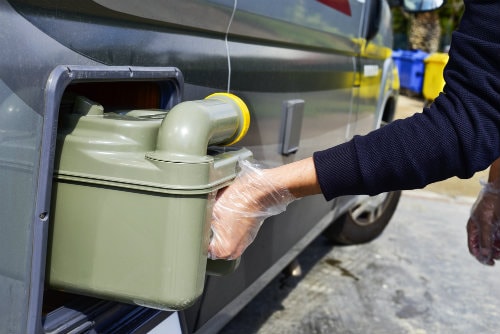In 1927, a custom RV was built. It was called the Flordellen and was 30 feet long. It was one of the first motor homes to have a bathroom and sewage tank built-in. The concept of a working bathroom was rare until the 1940s and 1950s. Since then, the bathroom in an RV has gone through some advancements, but the concepts are basically the same. The RV toilet empties into a sewage tank (called the black water tank) and is then emptied through a hose into a septic system.
RV Toilet
The toilet system in permanent structures like homes, hotels and other brick and mortar buildings works on water pressure. After you complete your biological need and flush, it uses water pressure to force the waste through a series of pipes. These pipes either feed into a labyrinth of sewer pipes to a city/county treatment plant or into a septic tank.
An RV toilet works primarily on gravity. Your toilet may have water that rinses the bowl and fills the bottom of it, but the water pressure from that is negligible. The advantage of this system is that there is low water use to preserve your freshwater tank. The waste from the toilet goes through a pipe to your black water holding tank. The tank holds all of the waste until it is emptied out through a flexible hose into a proper dump station receptacle.
In today’s RVs, the flushing mechanism can be a foot pedal or handle that opens the flushing door from the bowl to the pipes. Newer coaches can offer electric flushing systems like the Aria Deluxe II from Thetford that creates water pressure to help rinse the bowl out.
For decades, mainstream RV toilets were primarily plastic. Today you can get them in porcelain and various other materials. They can be built in, or a self-contained portable version.
Trailer Water Tanks

If your RV has a sink and bathroom, more than likely you have three different water storage tanks underneath your coach. Freshwater tanks can be as big as 60+ gallons. Black and grey tanks can be between 30-40 gallons.
- Freshwater Tank: The freshwater tank allows you to transport drinking water with you. These tanks vary in size. Besides drinking, this water is used in your toilet to rinse out your bowl. It also feeds your shower and any other built-in device that requires water to operate. When you are parked, you can attach a drinking water safe hose to an adapter on your RV, that avoids the freshwater tank.
- Grey Water Tank: Your grey water tank stores the dirty water from your sinks and showers. Be careful what goes down into this tank. It is only designed for liquids. The piping to empty this tank is only 1 ½ inch in diameter. If anything thick or solid goes into this tank, it can easily clog.
- Black Water Tank: The black water tank is just for your toilet. The emptying pipes are 3 inches thick and can handle biological waste and toilet paper. There are specially made toilet papers that must be used for your RV tank. Residential toilet paper will not fully break up and can clog your system.
Sewer Hose
Unlike the movie depiction, the RV sewer hose is sanitary. Usually, you only need one hose. If you do need to add an extension, there are adapters that keep a seal between the two hoses to prevent leaks. Back in the 1980s, these hoses were usually the color blue. Some still refer to this hose as the “Blue Hose.”
The hose itself looks like a slinky inside a flexible plastic tube. They are three to four inches wide and 10-20 feet long. They now come in various colors. They do make heavy-duty versions that use thicker plastic. The heavy-duty hose is usually recommended for environments that have the potential to rip the hose open. If you are primarily staying at developed campgrounds, the heavy-duty version is not needed.
To connect this hose, there should be a black PVC installation under your camper. It has two valves that act as a gate system to open and close your grey and black water tanks. To differentiate, your RV manufacturer should have labeled them in some way.
On the end of the black PVC, there should be tabs sticking out of the opening. This is where you attach your sewer hose. At your fully developed campsite or dump station, there should be a three to four-inch hole to place the other end of the sewer hose. You can either place a few inches of your hose down there or get a fitting that fits into the top of the underground pipe. Either way, make sure that your sewer hose will not disconnect.
When dumping, it’s always recommended that you empty the black tank contents first. Your grey water will flush out your sewer hose to prevent build-up.
If your tanks are not emptying out completely, or you are parked where your sewer hose is inclined, there are pumps to help suck out the waste. A macerator pump is a device you can connect to your sewer pipe to create a vacuum. The pump can grind up the solid material and push it hundreds of yards if need be. Instead of a sewer hose, most macerator pumps connect to standard garden hoses.
Toilet Chemicals
After a few uses, your RV bathroom can emanate an odor. To counter this, there are chemical treatments you can use to deodorize your toilet and sewer. They are also recommended for use due to their ability to break solids and toilet paper down. There are two main types.
- The first is the blue chemical type. These treatments have a more powerful breakdown agent in them. If you are dumping your toilet into your home’s septic tank, you may not want to use this type. One of the chemicals in the treatment is formaldehyde. This compound can destroy your septic system due to its high acidity. It can ruin the pipes and kill the good bacteria.
- The second type is the biological version. Instead of chemicals, it uses bacteria and other biological enzymes to break down the materials in your black tank. It is more environmentally conscious and will not hurt your septic system.
Make sure to only use these chemicals in your black tank only. If you need a deodorizer for your grey water tank, they do have other chemicals just for the grey tank.
Maintaining Your RV Toilet
Your RV’s toilet and sewer system will eventually need a tune-up once in a while.
- Toilet Seals: Your toilet will have rubber seals within it to prevent seepage onto your bathroom floor. These rubber seals can dry out and become rigid. To prevent this, you can take your toilet apart and spray the seals with a rubber conditioner like the 303 Rubber Seal Protectant and Conditioner. They will restore the rubber components to their original pliability to restore the seal.
If you do need to replace the seals, make sure you keep all of your product manuals in a secure location. You will need to know the model number of your toilet. Every toilet is built differently and you have to have the proper seal.
- Pipe Connections: At least once a year, go into your utility bay and look over your sewer pipe connections. The manufacturer uses strong adhesives to keep the pipes joined and sealed, yet they can degrade after years of use. If you suspect a leak, you can use a silicone caulk product. The silicone will create a seal of those connections.
- Black Tank Flushing System: A great way to maintain a healthy sewer system is to use a black tank flushing system. Think of it as a lawn sprinkler inside your tank. By using it, it can break down whatever build-up residue is inside the tank as well as clean off the tank sensors. This way, when you use your sensor panel inside your RV, it can be as accurate as possible.
If your RV does not have one installed, there are other ways you can have a flushing device. You can go online to look up how to install one yourself. Other options are the Camco RV Flexible Swivel Stik. This device connects to a water hose. You feed it down your toilet, through the pipes, into your black water tank. Once it’s in, you then turn on the water pressure and it rinses out the tank.
Your RV Toilet Will Work Worry-Free
When maintained, your RV toilet will work perfectly. They are built to take the vibrations of the road. RV toilets are mechanical and their parts are well-built. When taking your RV out, your RV toilet will not be a concern, except for emptying the tanks. Using the chemical treatment will keep your bathroom and toilet odor-free. Also, keep your sewer hose clear of debris that can puncture it to avoid a messy situation.




